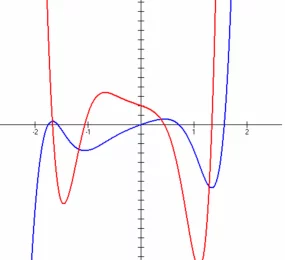Before we cover the Isosceles Triangle Theorem, we’ll discuss how we have used triangles over time in architecture, art, and design. Then we’ll talk about the history of isosceles triangles, the different types of triangles, and the different parts of isosceles triangles.
And lastly, after discussing the theorem, we’ll go over some useful formulas for calculating various parts of isosceles triangles.
Various Applications of Triangles

Image via: Flickr
While rectangles are more prevalent in architecture because they are easy to stack and organize, triangles provide more strength. With modern technology, triangles are easier to incorporate into building designs and are becoming more prevalent as a result.
In 1989, Japanese architects decided that a triangular building design would be necessary if they were to construct a 500-story building in Tokyo. The triangular shape could withstand earthquake forces, unlike a rectangular or square design.
You can also see triangular building designs in Norway, the Flatiron Building in New York, public buildings and colleges, and modern home designs.
As far as isosceles triangles, you see them in architecture, from ancient to modern. Ancient Egyptians used them to create pyramids. Ancient Greeks used obtuse isosceles triangles as the shapes of gables and pediments. In the Middle Ages, architects used what is called the Egyptian isosceles triangle, or an acute isosceles triangle.
You can also see isosceles triangles in the work of artists and designers going back to the Neolithic era. They are visible on flags, heraldry, and in religious symbols.
The History of Isosceles Triangles
The study of triangles is almost as old as civilization. Ancient Egyptians studied them as did Babylonians. You can see how ancient Egyptians used triangles to construct pyramids.
It wasn’t until about 300 BCE that the Greek mathematician, Euclid, gave triangles with two equal sides a name. He combined the Greek words “isos” (equal) and “skelos” (legs) to define them as triangles with exactly two sides.
Today, mathematicians define isosceles triangles as having at least two equal sides. This is a subtle but important difference because it means that equilateral triangles are also considered to be isosceles triangles. More on that below.
Other Types of Triangles
In the world of geometry, there are many types of triangles besides isosceles:
Isosceles triangles can also be acute, obtuse, or right, depending on their angle measurements. Equilateral triangles can be a type of isosceles triangle. However, note that not all isosceles triangles are equilateral. Moreover, an isosceles triangle can never be a scalene triangle.
There are a few particular types of isosceles triangles worth noting, such as the isosceles right triangle, or a 45-45-90 triangle. There is also the Calabi triangle, an obtuse isosceles triangle in which there are three different placements for the largest square.
And last but not least, there is also the golden triangle, which is an isosceles triangle where the duplicated leg is in the golden ratio to the distinct side. The golden ratio is defined as a ratio of two numbers in which the ratio of the sum to the bigger number is the same as the ratio of the larger number to the smaller.
The Parts of Isosceles Triangles

Image via: Flickr
No matter how you define isosceles triangles, they are all made up of two legs and a base. If it’s an equilateral triangle, all sides can be considered the base because all sides are equal.
And, there are two equal angles opposite the equal sides. Each of these angles is called a base angle. The angle in between the legs is the vertex angle.
Also, the angles opposite each leg are equal and always less than 90 degrees (acute). All total, the angles should add up to 180 degrees.
The Isosceles Triangle Theorem

Image via: Flickr
Finally, it’s time to discuss the Isosceles Triangle Theorem. The Isosceles Triangle Theorem states: In a triangle, angles the opposite to the equal sides are equal.
So, how do we go about proving it true? It’s pretty simple. First, we’re going to need to label the different parts of an isosceles triangle.
Let’s give the points of the isosceles triangle the labels A, B, and D (counterclockwise from the top). We also need to draw a line from the center of the base (BD) to the angle (A) on the other side. Note that the center of the base is termed midpoint, and angles on the inside of the triangle are called interior angles.
Where that line intersects the side is labeled C. The line creates two triangles, ABC and ACD.
So, Point C is on the base BD, creating line segment AC. Here’s what we have so far:
We have what is called the Side Side Postulate because all of the sides of ABC (three total) are congruent with ACD. If triangle ABC and triangle ACD have congruence, then their matching parts are congruent. This also proves that the B angle is congruent with the D angle.
The Converse of the Isosceles Triangle Theorem

Image via: Flickr
As with most mathematical theorems, there is a reverse of the Isosceles Triangle Theorem (usually referred to as the converse). It states, “if two angles of a triangle are congruent, the sides opposite to these angles are congruent.” Let’s work through it.
First, we’ll need another isosceles triangle, EFH. The EFH angle is congruent with the EHF angle. We need to prove that EF is congruent with EH. To do that, draw a line from FEH (E is the apex angle) to the base FH. Label this point on the base as G.
By doing this, we have made two right triangles, EFG and EGH. Because we have an angle bisector with the line segment EG, FEG is congruent with HEG. So what is the result?
We now have what’s known as the Angle Angle Side Theorem, or AAS Theorem, which states that two triangles are equal if two sides and the angle between them are equal.
Let’s take a look. We know that EFG is congruent with EHF. FEG is congruent with HEG. And EG is congruent with EG. That gives us two angles and a side, which is the AAS theorem.
When the triangles are proven to be congruent, the parts of the triangles are also congruent making EF congruent with EH. By working through everything above, we have proven true the converse (opposite) of the Isosceles Triangle Theorem.
Handy Calculations for Isosceles Triangles
In addition to understanding the Isosceles Triangle Theorem, you should also be familiar with a few basic equations for isosceles triangles.
Height
You can use the Pythagorean theorem to find the height of any triangle. First, label the two equal sides as a, and the base as b. The height (h) equals the square root of b2 – 1/4 a2. You can also divide the square root of 4a2 – b2in half and get the same result.
Perimeter
To measure the length of the outside of a triangle, add the length of each side together. But, since isosceles triangles have two equal sides, you can make the process easier with this formula: p = 2a + b.
Area
Area is defined as the total of unit squares you can fit inside any given shape. For an isosceles triangle, divide the total of the base (b) x height (h)by 2.
If you don’t know the height, use the formula listed above to calculate it.
Altitude
You can find the altitude of the isosceles triangle given the base (B) and the leg (L) by taking the square root of L2 – (B/2)2.
Base
To find the base of an isosceles triangle when you know the altitude (A) and leg (L), it is 2 x the square root of L2 – A2.
Leg
When given the base (B) and altitude (A), the leg is the square root of A2 + (B/2)2.
Interior Angle
When you know one interior angle of an isosceles triangle, it’s possible to find the other two. Let’s say that the angle at the apex is 40 degrees. Because angles must add up to 180 degrees, the two base angles need to add up to 140. Given they must be congruent angles, each of them must be 70 degrees.
Conclusion

Image via: Flickr
In this article, we have covered the history of isosceles triangles, the different types of triangles, useful formulas, and various applications of isosceles triangles.
We also discussed the Isosceles Triangle Theorem to help you mathematically prove congruent isosceles triangles. For a little something extra, we also covered the converse of the Isosceles Triangle Theorem. You should be well prepared when it comes time to test your knowledge of isosceles triangles.






